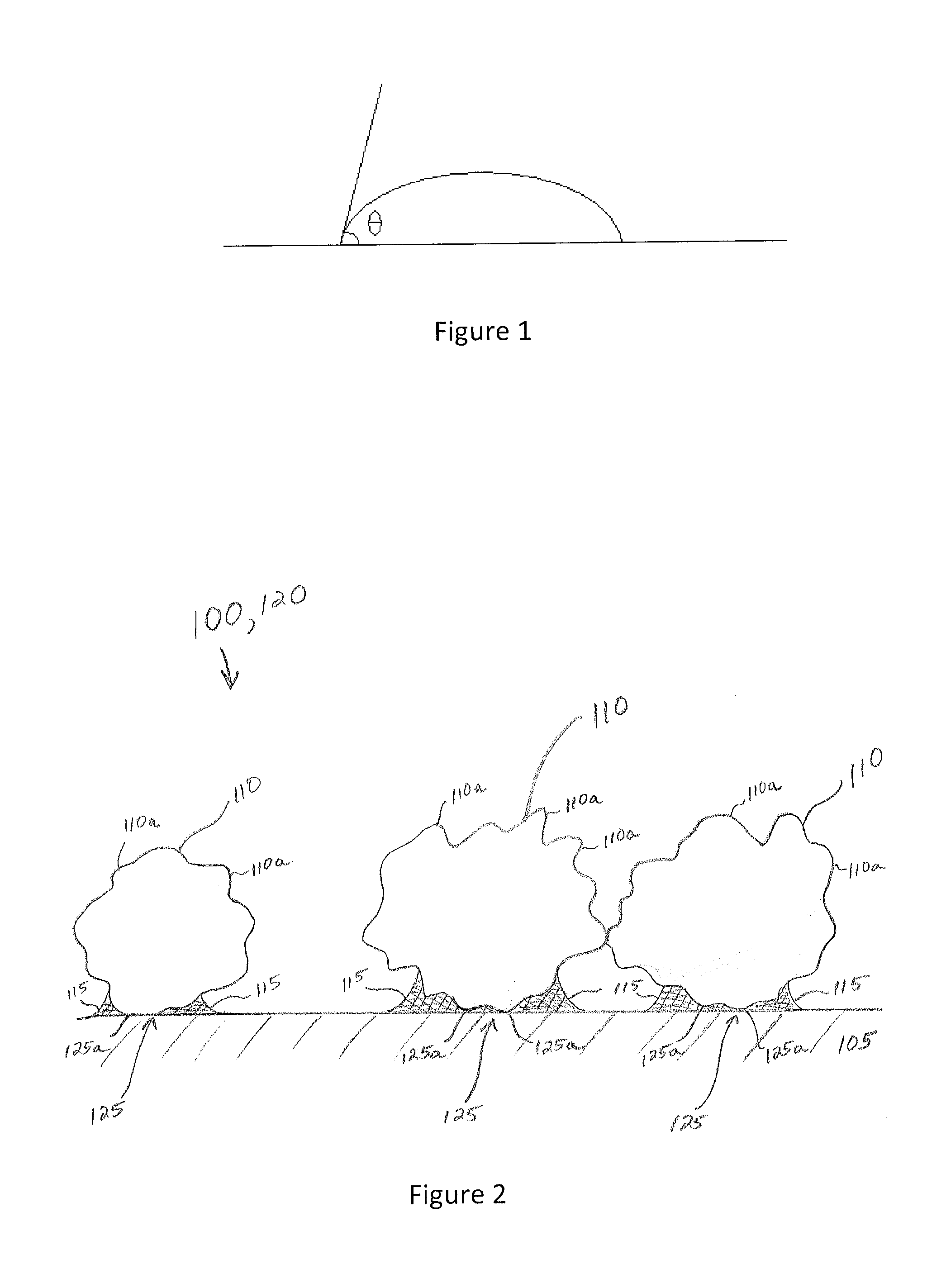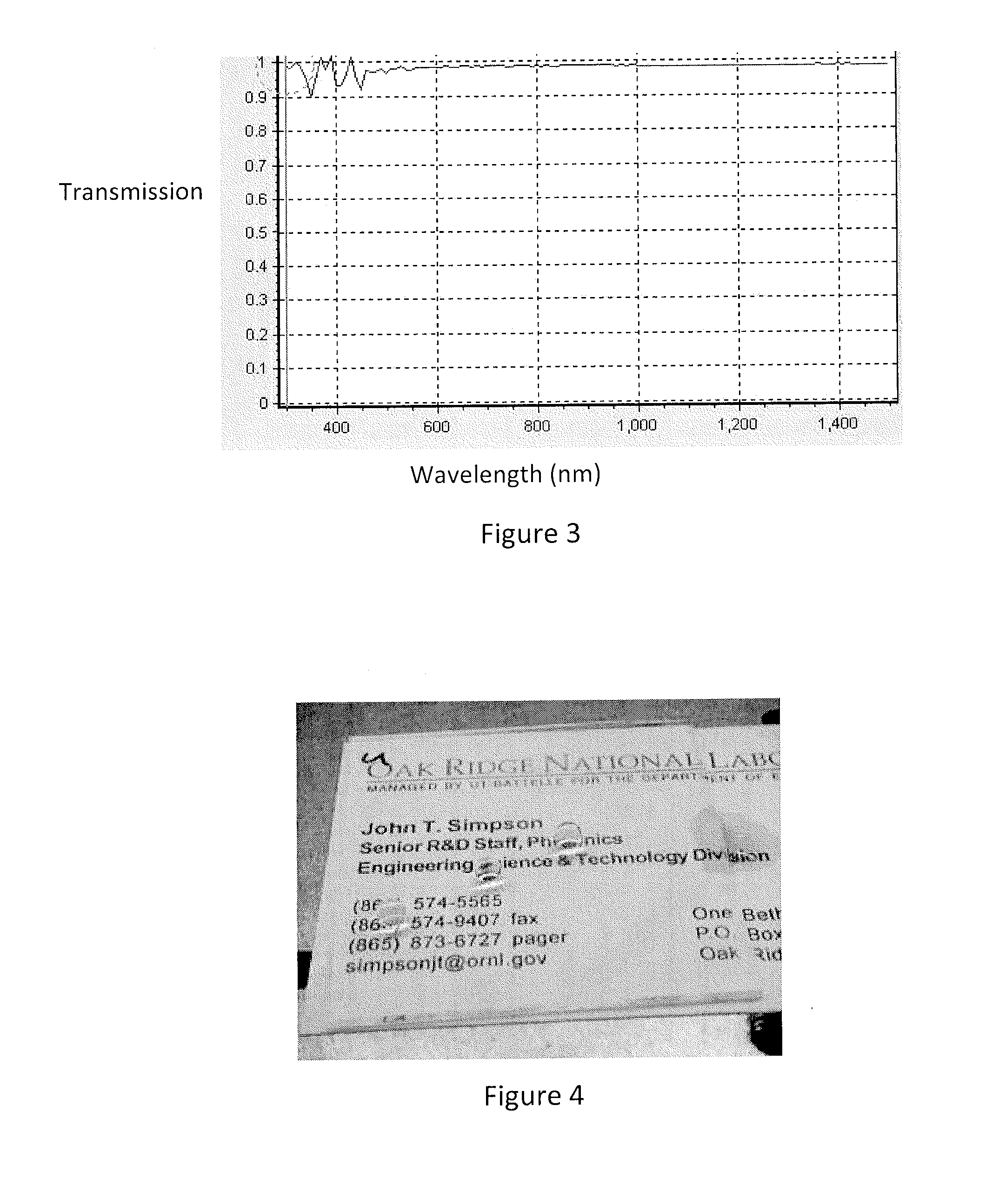Composition for forming an optically transparent, superhydrophobic coating
- Summary
- Abstract
- Description
- Claims
- Application Information
AI Technical Summary
Benefits of technology
Problems solved by technology
Method used
Image
Examples
example 1
[0035]An optically transparent superhydrophobic coating may be formed as described in this example using commercially available silica aerogel powder. First, a coating solution including Nanogel® aerogel powder at a concentration of 0.3 wt. % in Fluorinert™ FC-40 solvent is formed. To reduce the size of the aerogel particles and disperse them in the solution, the particle coating solution is sonicated using a high power ultrasonic probe for at least 20 minutes. The particles in the sonicated particle coating solution have an average particle size of about 200 nm or less. Any particle grains larger than about 200 nm may scatter visible light and cause the coating to become somewhat cloudy. Teflon-AF is then added to the sonicated solution as a binder at a concentration of 0.5 wt. %.
[0036]A clean glass slide is coated with the sonicated particle coating solution by spray coating, and the solvent is evaporated in a drying oven at 70° C. As the solvent evaporates, the Teflon-AF binder i...
example 2
[0038]The effect of binder concentration on bond strength and superhydrophobicity has been evaluated in a series of experiments in which the binder concentration was varied from 0.1% to 1.0% by 0.1% steps. Teflon-AF was employed as the binder in a coating solution including 0.3 wt. % aerogel particles in Fluorinert FC-40. The coating solution was sonicated for three hours to achieve an average particle size of about 100 nm and good dispersion of the powder in the solvent. The coating solution was applied to a glass substrate by spray coating. Evaporation of the solvent and curing of the binder occurred at room temperature.
[0039]The results indicated that the greater the binder percentage, the better the particle bonding, as expected. Bonding strength was evaluated using a simple rub test. Light rubbing caused small amounts of the coating to be removed. Moderate or vigorous rubbing completely removed the coating. It was thus concluded that the binder employed in the experiments, Tefl...
example 3
[0041]In another set of experiments, the amount of hydrophobic particles required in a coating solution to obtain a well-bonded, superhydrophobic coating having at least 90-95% particle surface coverage has been investigated.
[0042]A coating solution including acetone, 0.3% by weight of polyurethane (Clear Coat (CC)) and 0.3% by weight of silica aerogel particles was prepared. The aerogel particles had to be sonicated for five hours to sufficiently reduce the particle size such that a small amount of CC would hold the particles in place on a glass slide. Several different tests were carried out with the solution. The best results in terms of particle size reduction were obtained using an emulsifier at 8000 rpm for 15 minutes and a sonicator for 1 hour. It was found that if the solution of acetone, aerogel particles and the CC binder set for awhile, the coating results were very poor. Therefore, before using any coating solution, the solution was sonicated for a minimum of two minutes...
PUM
| Property | Measurement | Unit |
|---|---|---|
| particle size | aaaaa | aaaaa |
| particle size | aaaaa | aaaaa |
| water droplet contact angle | aaaaa | aaaaa |
Abstract
Description
Claims
Application Information
 Login to View More
Login to View More - R&D
- Intellectual Property
- Life Sciences
- Materials
- Tech Scout
- Unparalleled Data Quality
- Higher Quality Content
- 60% Fewer Hallucinations
Browse by: Latest US Patents, China's latest patents, Technical Efficacy Thesaurus, Application Domain, Technology Topic, Popular Technical Reports.
© 2025 PatSnap. All rights reserved.Legal|Privacy policy|Modern Slavery Act Transparency Statement|Sitemap|About US| Contact US: help@patsnap.com



